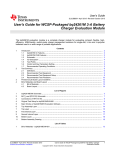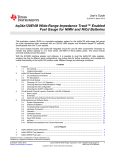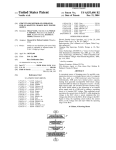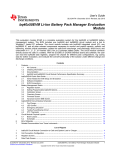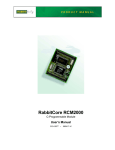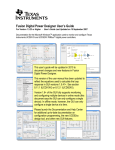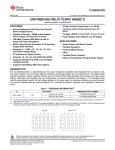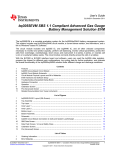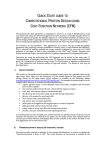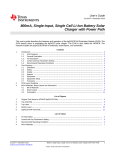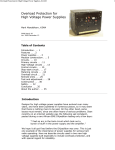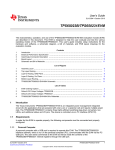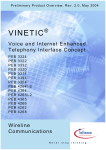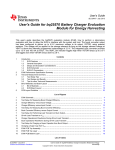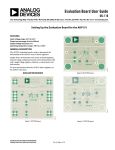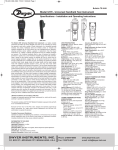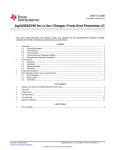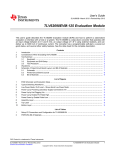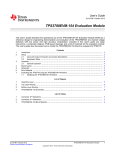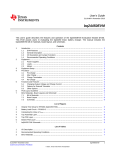Download WCSP-Packaged bq24160/161/163/168 Evaluation Module
Transcript
User's Guide SLUU496 – December 2011 WCSP-Packaged bq24160/161/163/168 Evaluation Module The bq24160/161/163/168 evaluation module is a complete charger module for evaluating compact, flexible, high-efficiency, USB-friendly, switch-mode charge management solution for single-cell, Li-ion and Li-polymer batteries used in a wide range of portable applications. 1 2 3 4 Contents Introduction .................................................................................................................. 2 1.1 bq2416x IC Features .............................................................................................. 2 1.2 bq24160/161/163/168 EVM Features ........................................................................... 2 1.3 Schematic ........................................................................................................... 3 1.4 I/O Description ...................................................................................................... 4 1.5 Test Points .......................................................................................................... 4 1.6 Control and Key Parameters Setting ............................................................................ 5 1.7 Recommended Operating Conditions ........................................................................... 5 Test Summary ............................................................................................................... 5 2.1 Definitions ........................................................................................................... 5 2.2 Recommended Test Equipment ................................................................................. 6 2.3 Recommended Test Equipment Setup .......................................................................... 7 2.4 Recommended Test Procedure .................................................................................. 9 Printed-Circuit Board Layout Guideline ................................................................................. 11 Bill of Materials and Board Layout ...................................................................................... 12 4.1 Bill of Materials .................................................................................................... 12 4.2 Board Layout ...................................................................................................... 14 List of Figures 1 bq24160/161/163/168EVM (HPA721) Schematic ...................................................................... 3 2 BAT_Load (PR1010) Schematic .......................................................................................... 6 3 Connections of HPA172 Kit................................................................................................ 8 4 Original Test Setup for bq24160/161/163/168EVM (HPA721) ........................................................ 8 5 Main Window of bq2416xSW Evaluation Software ..................................................................... 9 6 Top Assembly Layer ...................................................................................................... 14 7 Top Layer 8 9 10 .................................................................................................................. First Internal Layer ........................................................................................................ Second Internal Layer .................................................................................................... Bottom Layer ............................................................................................................... 14 15 15 16 List of Tables 1 Bill of Materials - HPA721 ............................................................................................... 12 I2C is a trademark of Philips Electronics N.V. SLUU496 – December 2011 Submit Documentation Feedback WCSP-Packaged bq24160/161/163/168 Evaluation Module Copyright © 2011, Texas Instruments Incorporated 1 Introduction 1 Introduction 1.1 bq2416x IC Features www.ti.com The bq24160/161/163/168 integrates a synchronous PWM controller, power MOSFETs, input-current sensing, high-accuracy current and voltage regulation, charge termination and power path management into a small WCSP package. The charge parameters can be programmed through an I2C interface. Key IC features include: • High-efficiency, fully integrated, NMOS-NMOS, synchronous buck charger with 1.5-MHz frequency • Integrated power FETs for up to 2.5-A charge rate • Power path management between battery and system voltages For details, see the bq24160/161/163/168 data sheet (SLUSAO0). 1.2 bq24160/161/163/168 EVM Features The bq24160/161/163/168 evaluation module (EVM) is a complete charger module for evaluating compact, flexible, high-efficiency, USB-friendly, switch-mode battery charge and power path management solution for single-cell, Li-ion and Li-polymer battery-powered systems used in a wide range of portable applications. Key EVM features include: • 153-mm × 153-mm × 1.2-mm footprint for entire solution • Input power connectors for both USB input and ac adapter • Programmable battery voltage, charge current, input current, and status via I2C™ interface • IN operating range of 4.2 V – 10 V (bq24160/161/163) or 4.2 V – 6 V (bq24168) • USB operating range of 4.2 V – 6 V • LED indication for status signals • Test points for key signals available for testing purposes. Easy probe hook-up 2 WCSP-Packaged bq24160/161/163/168 Evaluation Module Copyright © 2011, Texas Instruments Incorporated SLUU496 – December 2011 Submit Documentation Feedback Introduction www.ti.com 1.3 Schematic Figure 1. bq24160/161/163/168EVM (HPA721) Schematic SLUU496 – December 2011 Submit Documentation Feedback WCSP-Packaged bq24160/161/163/168 Evaluation Module Copyright © 2011, Texas Instruments Incorporated 3 Introduction www.ti.com NOTE: EVMs with a printed-circuit board label that contain the suffix -X may have been assembled with incorrectly marked ICs. Regardless of the IC’s marking, the EVM was assembled with the correct part number as specified in the EVM bill of material. 1.4 1.5 4 I/O Description Header/Terminal Block Description J1–TS External thermistor positive terminal J1–GND Ground terminal for external thermistor J2–BAT Battery positive header J3-BAT Battery positive terminal J3-GND Battery negative terminal J4-IN Adapter positive header J5-IN Adapter positive terminal J5-GND Adapter negative terminal J6-GND Battery negative terminal J7-GND Adapter negative terminal J8-USB USB positive header J9-USB USB positive terminal J9-GND USB negative terminal J10-SYS System output positive header J11-GND USB negative header J12 USB Miniconnector J13-SYS System output positive terminal J13-GND System output negative terminal J14-GND System output negative header J15-DRV DRV reference voltage positive header J16-DRV DRV reference voltage positive terminal J16-GND DRV reference voltage negative terminal J17 USB-TO-GPIO box connector Test Points Test Point Description TP1 Kelvin to VIN TP2 STAT TP3 Kelvin to BAT TP4 Kelvin to USB TP5 DRV TP6 INT TP7 Kelvin to SYS TP8 GND TP9 GND TP10 SW TP11 SCL TP12 SDA TP13 TS WCSP-Packaged bq24160/161/163/168 Evaluation Module Copyright © 2011, Texas Instruments Incorporated SLUU496 – December 2011 Submit Documentation Feedback Test Summary www.ti.com 1.6 1.7 Control and Key Parameters Setting Jumper Description JP1 1-2 (TS = INT): Connects a potentiometer to the TS so that the potentiometer can emulate a thermistor. The potentiometer has been preset to approximately 3.4 kΩ so that the TS voltage is 0.5 x V (DRV). 1-2 (TS = INT) 2-3 (TS = EXT): Connects the TS pin to an external thermistor. The resistor divider formed by R1 and R3 has been sized to accommodate a 10-kΩ thermistor. If a different thermistor is used, R1 and R3 must be resized. Default Factory Setting JP2 1-2 (FET GATE = SYS): External PFET's gate tied to SYS and therefore disabled. 2-3 (FET GATE = BGATE): External PFET's gate tied to BGATE pin and therefore controlled by IC. 2-3 (FET GATE = BGATE) JP3 Shorting jumper for USB data lines DM (D-) and DP (D+). When shorted, USB input current limit defaults to 1.5 A. Otherwise, USB100 mode is selected. SHORTED JP4 bq24161 and bq24162A only 1-2 (PSEL = LO): Indicates that an ac adapter is connected to the USB input and sets the USB input current limit to 1.5 A. 2-3 (PSEL = HI): Indicates that a USB source is connected to the USB input and sets the input current limit to 500 mA. 2-3 (PSEL = HI) JP5 1-2 (CD = LO): Charge disable low for normal operation 2-3 (CD = HI): Charge disable high to disable charge and enter Hi-Z mode 1-2 (CD = LO) Recommended Operating Conditions Min Max Unit Input voltage from ac adapter (bq24160/161/163) 4.2 10 V Supply voltage, VIN Input voltage from ac adapter (bq24168) 4.2 6 V USB voltage, VUSB Input voltage from USB or equivalent supply 4.2 6 V System voltage, VSYS Voltage output at SYS terminal (bq24160/161/168; depends on VBAT voltage and status of VINDPM) 3.3 VBATR EG+4.17 % V System voltage, VSYS Voltage output at SYS terminal (bq24163; depends on VBAT voltage and status of VINDPM) 3.1 VBATR EG+4.17 % V Battery voltage, VBAT Voltage output at VBAT terminal (registers set via I2C communication) 4.44 V Supply current, IIN(MAX) Maximum input current from ac adapter input (registers set via I2C communication) 1.5 2.5 A Supply current, IUSB(MAX) Maximum input current from USB input (registers set via I2C communication) 0.1 1.5 A Fast charge current, ICHRG(MAX) Battery charge current (registers set via I2C communication) 0.550 2.5 A -40 125 °C Operating junction temperature range, TJ 2 Typ Supply voltage, VIN 3 4.2 0.5 Test Summary This procedure describes one test configuration of the HPA721 evaluation board for bench evaluation. 2.1 Definitions The following naming conventions are followed. VXXX : LOADW: V(TPyyy): V(Jxx): SLUU496 – December 2011 Submit Documentation Feedback External voltage supply name (VADP, VBT, VSBT) External load name (LOADR, LOADI) Voltage at internal test point TPyyy. For example, V(TP12) means the voltage at TP12. Voltage at header Jxx WCSP-Packaged bq24160/161/163/168 Evaluation Module Copyright © 2011, Texas Instruments Incorporated 5 Test Summary V(TP(XXX)): V(XXX, YYY): I(JXX(YYY)): Jxx(BBB): JPx ON : JPx OFF: JPx (-YY-) Measure: → A,B Observe → A,B www.ti.com Voltage at test point XXX. For example, V(ACDET) means the voltage at the test point which is marked as ACDET. Voltage across point XXX and YYY. Current going out from the YYY terminal of header XX. Terminal or pin BBB of header xx. Internal jumper Jxx terminals are shorted. Internal jumper Jxx terminals are open. ON: Internal jumper Jxx adjacent terminals marked as YY are shorted. Check specified parameters A, B. If measured values are not within specified limits, the unit under test has failed. Observe if A, B occur. If they do not occur, the unit under test has failed. Assembly drawings have location for jumpers, test points, and individual components. 2.2 Recommended Test Equipment 2.2.1 Power Supplies 1. Power Supply #1 (PS #1) capable of supplying 6 V at 3 A is required. 2. If not using a battery as the load, then power supply #2 (PS #2) capable of supplying up to 5 V at 5 A is required to power the circuit shown in Figure 2. 2.2.2 Load #1 Between BAT and GND Testing with an actual battery is the best way to verify operation in the system. If a battery is not available, then a battery or circuit similar to the one shown inFigure 2 can simulate a battery when connected to a power supply. Figure 2. BAT_Load (PR1010) Schematic 2.2.3 Load #2 Between SYS and GND Although not required, a resistive load capable of sinking up to 3 A can be used. 6 WCSP-Packaged bq24160/161/163/168 Evaluation Module Copyright © 2011, Texas Instruments Incorporated SLUU496 – December 2011 Submit Documentation Feedback Test Summary www.ti.com 2.2.4 Meters Four equivalent voltage meters (VM #) and two equivalent current meters (CM #) are required. The current meters must be able to measure 3-A current. 2.2.5 Computer A computer with at least one USB port and a USB cable is required. The bq2416x evaluation software must be properly installed. 2.2.6 HPA172 Communication Kit (USB TO GPIO) A HPA172 USB-to-I2C communication kit is required. 2.2.7 Software Download BQ2416xSW.zip from the charger's product folder, unzip the file, and double-click on the SETUP.EXE file. Follow the installation steps. Because the bq24160, bq24161, and bq24163 have the watchdog timers enabled, it is recommended that you set the software's Reset Watchdog Timer to reset every 5 seconds. Otherwise, after 30 seconds of operation, the IC enters Default mode. Note that the 27-minute safety timer is not reset by this function and eventually times out if charging does not complete, unless the Safety Timer Time Limit is expanded or disabled via the GUI. One way to reset the safety timer is to allow the 30-second watchdog timer to expire. See Figure 3 in the data sheet for more information about the timers. Also, it is generally helpful to activate the Write On Change functions, in the upper left of the GUI window, to ON. The Write On Change function writes any changes to the GUI's check boxes, drop-down boxes, and registers to the IC. Otherwise, the user must click the WRITE button to write changes to the software. It is recommended that the user periodically click the READ button to find the IC's instantaneous status. Alternatively, the AutoRead function can be activated to periodically update the GUI with the IC's status. 2.3 Recommended Test Equipment Setup 1. For all power connections, use short, twisted-pair wires of appropriate gauge wire for the amount of the current. 2. Set Power Supply #1 (PS #1) for 6-V, 3-A current limit and then turn off supply. 3. If BAT_Load is the circuit shown in Figure 1, connect Power Supply #2 (PS #2) set to approximately 3.6 V to the input side (PS #2+/-) of BAT_Load, then turn off PS #2. 4. Connect the output side of the battery or BAT_Load in series with current meter (multimeter) #2 (CM #2) to J2 and J6 or J3 (BAT, GND). Ensure that a voltage meter is connected across J2 or TP3 and J6 or TP9 (BAT, GND). 5. Connect VM #3 across J10 or TP7 and J14 or TP9 (SYS, GND). 6. Connect VM #4 across J15 or TP5 and J14 or TP9 (DRV, GND). 7. Connect J17 to HPA172 kit by the 10-pin ribbon cable. Connect the USB port of the HPA172 kit to the USB port of the computer. The connections are shown in Figure 3. SLUU496 – December 2011 Submit Documentation Feedback WCSP-Packaged bq24160/161/163/168 Evaluation Module Copyright © 2011, Texas Instruments Incorporated 7 Test Summary www.ti.com I/O USB Interface Adapter Texas Instruments © 2006 USB 10-pin Ribbon Cable To Computer USB port To EVM Figure 3. Connections of HPA172 Kit 8. Ensure jumpers are at the default factory settings per Section 1.6 9. After the preceding steps have been performed, the test setup for HPA721 is configured as is shown in Figure 4 Windows PC USB-TOGPIO CM#1 VM#1 + + PS #1 V A PS#2 IIN ICHRG - A + CM#2 V V VM#2 + + - BAT_Load VM#3 - V + VM#4 Figure 4. Original Test Setup for bq24160/161/163/168EVM (HPA721) 8 WCSP-Packaged bq24160/161/163/168 Evaluation Module Copyright © 2011, Texas Instruments Incorporated SLUU496 – December 2011 Submit Documentation Feedback Test Summary www.ti.com 10. Turn on the computer. Open the bq2416x evaluation software. The main window of the software is shown in Figure 5 Figure 5. Main Window of bq2416xSW Evaluation Software 2.4 Recommended Test Procedure The following test procedure may be useful for evaluating the charger IC outside of a real system, if no battery is available to connect to the output and a simulated battery if needed. 2.4.1 1. 2. 3. 4. 5. 6. 7. Charge Voltage and Current Regulation of IN Ensure that the Section 2.3 steps are followed. Connect the output of Power Supply #1 (PS #1) in series with current meter (multimeter) #1 (CM #1) to J4 and J7 or J5 (IN, GND). Connect voltage meter 1 (VM #1) across J4 or TP1 and J7 or TP8 (IN, GND). Move JP5 to HI. Turn on PS #1 and PS #2 if used. Return JP5 to LO. Software setup: • Press the READ button to obtain the current settings. SLUU496 – December 2011 Submit Documentation Feedback WCSP-Packaged bq24160/161/163/168 Evaluation Module Copyright © 2011, Texas Instruments Incorporated 9 Test Summary www.ti.com • Set Write On Change to ON if not already set. • Set Reset Watchdog Timer to update every 5 seconds. • Set Supply Precedence to IN if not already set. • Uncheck Disable Charging if checked. • Check Enable STAT/INT Outputs. • Set Battery Regulation Voltage to 4.20 V. • Set IN Input Current Limit to 2.5 A. • Set Charge Current to 1000 mA. • Click the READ button at the top of the window and confirm that the previous settings remain. 8. For the bq24160 EVM, enable PS #2 and adjust PS #2 so that the voltage measured by VM #2, across BAT and GND, measures 3.2 V ± 50 mV. For the bq24161/163/168 EVMs, enable PS #2 and adjust PS #2 so that the voltage measured by VM #2, across BAT and GND, measures 2.5 V ± 50 mV. 9. Adjust the power supply so that VM #1 still reads 6 V ± 100 mV, if necessary, then Measure on CM#2 → ICHRG = 1000 mA ± 100 mA Measure on CM#1 → IIN = 700 mA ± 70 mA 10. Turn off PS #1 and PS #2. 2.4.2 Charge Voltage and Current Regulation of USB 1. Ensure that the Section 2.3 steps are followed. 2. Connect the output of Power Supply #1 (PS #1) in series with current meter (multimeter) #1 (CM #1) to J8 and J11 or J9 (USB, GND). 3. Connect a voltage meter 1 (VM #1) across J8 or TP4 and J11 or TP8 (USB, GND). 4. Move JP5 to HI. 5. Turn on PS #1 and PS #2 if used. 6. Return JP5 to LO. 7. Software setup: • Press the READ button to obtain the current settings. • Set Write On Change to ON if not already set. • Set Reset Watchdog Timer to update every 5 seconds. • Set Supply Precedence to USB if not already set. • Uncheck Disable Charging if checked. • Check Enable STAT/INT Outputs. • Set Battery Regulation Voltage to 4.20 V. • Set USB Input Current Limit to 1500 mA. • Set Charge Current to 1000 mA. • Click the READ button at the top of the window, and confirm that the previous settings remain. 8. For the bq24160 EVM, enable PS #2 and adjust PS #2 so that the voltage measured by VM #2, across BAT and GND, measures 3.2 V ± 50 mV. For the bq24161/163/168 EVMs, enable PS #2 and adjust PS #2 so that the voltage measured by VM #2, across BAT and GND, measures 2.5 V ± 50 mV. 9. Adjust the power supply so that VM #1 still reads 6 V ± 100 mV if necessary then Measure on CM#2 → ICHRG = 1000 mA ± 100 mA Measure on CM#1 → IIN = 700 mA ± 70 mA 10. Turn off PS #1 and PS #2. 2.4.3 Helpful hints 1. To observe the taper current as the battery voltage approaches the set regulation voltage, allow the battery to charge or, if using BAT_Load (PR1010), slowly increase the PS #2 voltage powering BAT_Load (PR1010). Use VM #2 across BAT and GND to measure the battery voltage seen by the IC. 10 WCSP-Packaged bq24160/161/163/168 Evaluation Module Copyright © 2011, Texas Instruments Incorporated SLUU496 – December 2011 Submit Documentation Feedback Printed-Circuit Board Layout Guideline www.ti.com 2. To observe the VINDPM function, lower the current limit on PS #1. 3. To observe battery supplement mode, apply a resistive load across SYS and GND that is higher than the maximum charge current. 3 Printed-Circuit Board Layout Guideline 1. To obtain optimal performance, the power input capacitors, connected from the PMID input to PGND, must be placed as close as possible to the bq2416x 2. Place 4.7-µF input capacitor as close to PMID pin and PGND pin as possible to make the high-frequency current loop area as small as possible. Place 1-µF input capacitor GNDs as close to the respective PMID capacitor GND and PGND pins as possible to minimize the ground difference between the input and PMID_. 3. The local bypass capacitor from SYS to GND must be connected between the SYS pin and PGND of the IC. The intent is to minimize the current path loop area from the SW pin through the LC filter and back to the PGND pin. 4. Place all decoupling capacitors close to their respective IC pins and as close as to PGND (do not place components such that routing interrupts power stage currents). All small control signals must be routed away from the high-current paths. 5. The PCB must have a ground plane (return) connected directly to the return of all components through vias (two vias per capacitor for power-stage capacitors, one via per capacitor for small-signal components). It is also recommended to put vias inside the PGND pads for the IC, if possible. A star ground design approach is typically used to keep circuit block currents isolated (high-power/low-power small-signal) which reduces noise-coupling and ground-bounce issues. A single ground plane for this design gives good results. With this small layout and a single ground plane, no ground-bounce issue exists, and having the components segregated minimizes coupling between signals. 6. The high-current charge paths into IN, USB, BAT, SYS, and from the SW pins must be sized appropriately for the maximum charge current in order to avoid voltage drops in these traces. The PGND pins must be connected to the ground plane to return current through the internal low-side FET. 7. For high-current applications, the balls for the power paths must be connected to as much copper in the board as possible. This allows better thermal performance because the board conducts heat away from the IC. SLUU496 – December 2011 Submit Documentation Feedback WCSP-Packaged bq24160/161/163/168 Evaluation Module Copyright © 2011, Texas Instruments Incorporated 11 Bill of Materials and Board Layout www.ti.com 4 Bill of Materials and Board Layout 4.1 Bill of Materials Table 1. Bill of Materials - HPA721 Count RefDes Value Description Size Part Number MFR 2 C1, C3 1 µF Capacitor, Ceramic, 25V, X5R, 10% 603 Std Std 2 C2, C5 1 µF Capacitor, Ceramic, 6.3V, X5R, 10% 402 Std Std 1 1 C4, C12 47 µF Capacitor, Ceramic, 6.3V, X5R, 10% 1206 Std Std 0 0 0 C6, C10 Open Capacitor, Ceramic 1206 Std Std 2 2 2 2 C7, C8 4.7 µF Capacitor, Ceramic, 25V, X5R, 10% 805 Std Std 1 1 1 1 C9 0.01 µF Capacitor, Ceramic, 16V, X7R, 10% 603 Std Std 1 1 1 1 C11 10 µF Capacitor, Ceramic, 10V, X5R, 10% 603 Std Std 2 2 2 2 D1, D2 Green Diode, LED, Green, 2.1-V, 20-mA, 6-mcd 603 LTST-C190GKT Liteon 6 6 6 6 J1, J3, J5, J9, J13, J16 ED555/2DS Terminal Block, 2-pin, 6-A, 3.5mm 0.27 x 0.25 ED555/2DS OST 1 1 1 1 J12 UX60-MB-5ST Connector, Recpt, USB-B, Mini, 5-pins, SMT 0.354 X 0.303 Inches UX60-MB-5ST Hiroise Electrical Co 1 1 1 1 J17 N2510-6002-RB Connector, Male Straight 2x5 pin, 100mil spacing, 4 Wall 0.338 x 0.788 inch N2510-6002-RB 3M 9 9 9 9 J2, J4, J6, J7, J8, J10, J11, J14, J15 PEC02SAAN Header, Male 2-pin, 100mil spacing 0.100 inch x 2 PEC02SAAN Sullins 3 3 3 3 JP1, JP2, JP5 PEC03SAAN Header, Male 3-pin, 100mil spacing, 0.100 inch x 3 PEC03SAAN Sullins 1 1 1 1 JP3 PEC02SAAN Header, Male 2-pin, 100mil spacing, 0.100 inch x 2 PEC02SAAN Sullins 0 1 1 0 JP4 PEC03SAAN Header, Male 3-pin, 100mil spacing, 0.100 inch x 3 PEC03SAAN Sullins 1 1 1 1 L1 1.5µH Inductor, SMT, 3.5A, 70 mW 4.1x4.4 mm SPM4012T-1R5M Alternate: FDSD0415-H-1R5M TD Alternate: Toko 1 1 1 1 Q1 CSD25401Q3 MOSFET, PChan, -20V, 60A, 8.7 mΩ QFN3.3X3.3mm CSD25401Q3 TI 1 1 1 1 R1 1870 Resistor, Chip, 1/16W, 1% 603 Std Std 1 1 1 1 R2 50.0k Potentiometer, 3/8 Cermet, 12-Turn 0.25x0.17 inch 3266W-1-503LF Bourns 1 1 1 1 R3 4120 Resistor, Chip, 1/16W, 1% 603 Std Std 1 0 0 1 R4 0 Resistor, Chip, 1/16W, 1% 603 Std Std 2 2 2 2 R5, R6 1.50K Resistor, Chip, 1/16W, 1% 603 Std Std 2 2 2 2 R7, R8 200 Resistor, Chip, 1/16W, 1% 603 Std Std 8 8 8 8 TP1, TP2, TP3, TP4, TP5, TP6, TP7, TP10 5000 Test Point, Red, Thru Hole Color Keyed 0.100 x 0.100 inch 5000 Keystone 2 2 2 2 TP8, TP9 5001 Test Point, Black, Thru Hole Color Keyed 0.100 x 0.100 inch 5001 Keystone 3 3 3 3 TP11, TP12, TP13 5002 Test Point, White, Thru Hole Color Keyed 0.100 x 0.100 inch 5002 Keystone 1 0 0 1 U1 BQ24160YFF IC, 2.5A, Dual-Input, Single Cell Switch-mode Li-Ion BATTERY CHARGER with QFN3.3X3.3mm BQ24160YFF TI -001 -002 -003 2 2 2 2 2 2 1 1 0 12 -004 SLUU496 – December 2011 Submit Documentation Feedback WCSP-Packaged bq24160/161/163/168 Evaluation Module Copyright © 2011, Texas Instruments Incorporated Bill of Materials and Board Layout www.ti.com Table 1. Bill of Materials - HPA721 (continued) Count RefDes Value Description Size Part Number MFR 0 U1 BQ24161YFF IC, 2.5A, Dual-Input, Single Cell Switch-mode Li-Ion BATTERY CHARGER with QFN3.3X3.3mm BQ24161YFF TI 1 0 U1 BQ24168YFF IC, 2.5A, Dual-Input, Single Cell Switch-mode Li-Ion BATTERY CHARGER with QFN3.3X3.3mm BQ24168YFF TI 0 0 1 U1 BQ24163YFF IC, 2.5A, Dual-Input, Single Cell Switch-mode Li-Ion BATTERY CHARGER with QFN3.3X3.3mm BQ24163YFF TI 5 5 4 — Shunt, 100-mil, Black 0.100 929950-00 3M -001 -002 -003 0 1 0 0 0 0 4 -004 SLUU496 – December 2011 Submit Documentation Feedback WCSP-Packaged bq24160/161/163/168 Evaluation Module Copyright © 2011, Texas Instruments Incorporated 13 Bill of Materials and Board Layout 4.2 www.ti.com Board Layout TEXAS INSTRUMENTS Figure 6. Top Assembly Layer Figure 7. Top Layer 14 WCSP-Packaged bq24160/161/163/168 Evaluation Module Copyright © 2011, Texas Instruments Incorporated SLUU496 – December 2011 Submit Documentation Feedback Bill of Materials and Board Layout www.ti.com Figure 8. First Internal Layer Figure 9. Second Internal Layer SLUU496 – December 2011 Submit Documentation Feedback WCSP-Packaged bq24160/161/163/168 Evaluation Module Copyright © 2011, Texas Instruments Incorporated 15 Bill of Materials and Board Layout www.ti.com Figure 10. Bottom Layer 16 WCSP-Packaged bq24160/161/163/168 Evaluation Module Copyright © 2011, Texas Instruments Incorporated SLUU496 – December 2011 Submit Documentation Feedback Evaluation Board/Kit Important Notice Texas Instruments (TI) provides the enclosed product(s) under the following conditions: This evaluation board/kit is intended for use for ENGINEERING DEVELOPMENT, DEMONSTRATION, OR EVALUATION PURPOSES ONLY and is not considered by TI to be a finished end-product fit for general consumer use. Persons handling the product(s) must have electronics training and observe good engineering practice standards. As such, the goods being provided are not intended to be complete in terms of required design-, marketing-, and/or manufacturing-related protective considerations, including product safety and environmental measures typically found in end products that incorporate such semiconductor components or circuit boards. This evaluation board/kit does not fall within the scope of the European Union directives regarding electromagnetic compatibility, restricted substances (RoHS), recycling (WEEE), FCC, CE or UL, and therefore may not meet the technical requirements of these directives or other related directives. Should this evaluation board/kit not meet the specifications indicated in the User’s Guide, the board/kit may be returned within 30 days from the date of delivery for a full refund. THE FOREGOING WARRANTY IS THE EXCLUSIVE WARRANTY MADE BY SELLER TO BUYER AND IS IN LIEU OF ALL OTHER WARRANTIES, EXPRESSED, IMPLIED, OR STATUTORY, INCLUDING ANY WARRANTY OF MERCHANTABILITY OR FITNESS FOR ANY PARTICULAR PURPOSE. The user assumes all responsibility and liability for proper and safe handling of the goods. Further, the user indemnifies TI from all claims arising from the handling or use of the goods. Due to the open construction of the product, it is the user’s responsibility to take any and all appropriate precautions with regard to electrostatic discharge. EXCEPT TO THE EXTENT OF THE INDEMNITY SET FORTH ABOVE, NEITHER PARTY SHALL BE LIABLE TO THE OTHER FOR ANY INDIRECT, SPECIAL, INCIDENTAL, OR CONSEQUENTIAL DAMAGES. TI currently deals with a variety of customers for products, and therefore our arrangement with the user is not exclusive. TI assumes no liability for applications assistance, customer product design, software performance, or infringement of patents or services described herein. Please read the User’s Guide and, specifically, the Warnings and Restrictions notice in the User’s Guide prior to handling the product. This notice contains important safety information about temperatures and voltages. For additional information on TI’s environmental and/or safety programs, please contact the TI application engineer or visit www.ti.com/esh. No license is granted under any patent right or other intellectual property right of TI covering or relating to any machine, process, or combination in which such TI products or services might be or are used. FCC Warning This evaluation board/kit is intended for use for ENGINEERING DEVELOPMENT, DEMONSTRATION, OR EVALUATION PURPOSES ONLY and is not considered by TI to be a finished end-product fit for general consumer use. It generates, uses, and can radiate radio frequency energy and has not been tested for compliance with the limits of computing devices pursuant to part 15 of FCC rules, which are designed to provide reasonable protection against radio frequency interference. Operation of this equipment in other environments may cause interference with radio communications, in which case the user at his own expense will be required to take whatever measures may be required to correct this interference. EVM Warnings and Restrictions It is important to operate this EVM within the input voltage range of 4 V to 6 V and the output voltage range of 0 V to 4.44 V . Exceeding the specified input range may cause unexpected operation and/or irreversible damage to the EVM. If there are questions concerning the input range, please contact a TI field representative prior to connecting the input power. Applying loads outside of the specified output range may result in unintended operation and/or possible permanent damage to the EVM. Please consult the EVM User's Guide prior to connecting any load to the EVM output. If there is uncertainty as to the load specification, please contact a TI field representative. During normal operation, some circuit components may have case temperatures greater than 65°C. The EVM is designed to operate properly with certain components above 125°C as long as the input and output ranges are maintained. These components include but are not limited to linear regulators, switching transistors, pass transistors, and current sense resistors. These types of devices can be identified using the EVM schematic located in the EVM User's Guide. When placing measurement probes near these devices during operation, please be aware that these devices may be very warm to the touch. Mailing Address: Texas Instruments, Post Office Box 655303, Dallas, Texas 75265 Copyright © 2011, Texas Instruments Incorporated IMPORTANT NOTICE Texas Instruments Incorporated and its subsidiaries (TI) reserve the right to make corrections, modifications, enhancements, improvements, and other changes to its products and services at any time and to discontinue any product or service without notice. Customers should obtain the latest relevant information before placing orders and should verify that such information is current and complete. All products are sold subject to TI’s terms and conditions of sale supplied at the time of order acknowledgment. TI warrants performance of its hardware products to the specifications applicable at the time of sale in accordance with TI’s standard warranty. Testing and other quality control techniques are used to the extent TI deems necessary to support this warranty. Except where mandated by government requirements, testing of all parameters of each product is not necessarily performed. TI assumes no liability for applications assistance or customer product design. Customers are responsible for their products and applications using TI components. To minimize the risks associated with customer products and applications, customers should provide adequate design and operating safeguards. TI does not warrant or represent that any license, either express or implied, is granted under any TI patent right, copyright, mask work right, or other TI intellectual property right relating to any combination, machine, or process in which TI products or services are used. Information published by TI regarding third-party products or services does not constitute a license from TI to use such products or services or a warranty or endorsement thereof. Use of such information may require a license from a third party under the patents or other intellectual property of the third party, or a license from TI under the patents or other intellectual property of TI. Reproduction of TI information in TI data books or data sheets is permissible only if reproduction is without alteration and is accompanied by all associated warranties, conditions, limitations, and notices. Reproduction of this information with alteration is an unfair and deceptive business practice. TI is not responsible or liable for such altered documentation. Information of third parties may be subject to additional restrictions. Resale of TI products or services with statements different from or beyond the parameters stated by TI for that product or service voids all express and any implied warranties for the associated TI product or service and is an unfair and deceptive business practice. TI is not responsible or liable for any such statements. TI products are not authorized for use in safety-critical applications (such as life support) where a failure of the TI product would reasonably be expected to cause severe personal injury or death, unless officers of the parties have executed an agreement specifically governing such use. Buyers represent that they have all necessary expertise in the safety and regulatory ramifications of their applications, and acknowledge and agree that they are solely responsible for all legal, regulatory and safety-related requirements concerning their products and any use of TI products in such safety-critical applications, notwithstanding any applications-related information or support that may be provided by TI. Further, Buyers must fully indemnify TI and its representatives against any damages arising out of the use of TI products in such safety-critical applications. TI products are neither designed nor intended for use in military/aerospace applications or environments unless the TI products are specifically designated by TI as military-grade or "enhanced plastic." Only products designated by TI as military-grade meet military specifications. Buyers acknowledge and agree that any such use of TI products which TI has not designated as military-grade is solely at the Buyer's risk, and that they are solely responsible for compliance with all legal and regulatory requirements in connection with such use. TI products are neither designed nor intended for use in automotive applications or environments unless the specific TI products are designated by TI as compliant with ISO/TS 16949 requirements. Buyers acknowledge and agree that, if they use any non-designated products in automotive applications, TI will not be responsible for any failure to meet such requirements. Following are URLs where you can obtain information on other Texas Instruments products and application solutions: Products Applications Audio www.ti.com/audio Communications and Telecom www.ti.com/communications Amplifiers amplifier.ti.com Computers and Peripherals www.ti.com/computers Data Converters dataconverter.ti.com Consumer Electronics www.ti.com/consumer-apps DLP® Products www.dlp.com Energy and Lighting www.ti.com/energy DSP dsp.ti.com Industrial www.ti.com/industrial Clocks and Timers www.ti.com/clocks Medical www.ti.com/medical Interface interface.ti.com Security www.ti.com/security Logic logic.ti.com Space, Avionics and Defense www.ti.com/space-avionics-defense Power Mgmt power.ti.com Transportation and Automotive www.ti.com/automotive Microcontrollers microcontroller.ti.com Video and Imaging RFID www.ti-rfid.com OMAP Mobile Processors www.ti.com/omap Wireless Connectivity www.ti.com/wirelessconnectivity TI E2E Community Home Page www.ti.com/video e2e.ti.com Mailing Address: Texas Instruments, Post Office Box 655303, Dallas, Texas 75265 Copyright © 2011, Texas Instruments Incorporated


















